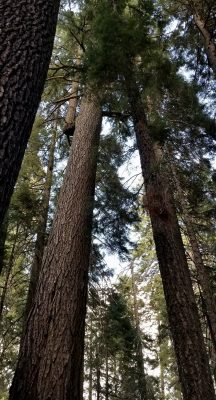Opportunities to explore some of the most beautiful corners of the Plumas National Forest with top experts from the U.S. Forest Service, Feather River College, and other organizations are provided through an upcoming field trip series starting this Friday.
“If you’re wondering what Friends of Plumas Wilderness is proposing to protect, and what it means for active forest management, fire fighting, and recreation access, come out in the field with us,” said Darla DeRuiter, Executive Director. “These are such important topics to all of us. We want to hear from you too!”
The Valley Creek Botanical Special Interest Area near La Porte will be dedicated as an Old Growth Network reserve on Friday, August 12th. Forest Service ecologist Michelle Coppoletta and Feather River District Ranger Dave Brillenz, along with Noel Collins from Old Growth Forest Network and representatives from Friends of Plumas Wilderness will provide a guided tour of this special area. Old and mature growth forests are increasingly rare and they provide important ecosystem services, including wildlife habitat, carbon sequestration, and groundwater recharge.
The Old Growth Network status has no permanent protection status with the federal government. There are four tools of protection that Friends of Plumas Wilderness is exploring that are permanent. Through the field trip series, information will be shared about each of these tools: Research Natural Areas, Wild & Scenic Rivers, Wilderness Areas, and National Monuments.
The globally rare Baker Cypress is featured at the second outing, which is about Research Natural Areas (RNA). The Wheeler Peak Unit of the Mud Lake RNA hosts the world’s largest Baker Cypress. Join Forest Service ecologist Kyle Merriam and Ryan Bauer, Plumas National Forest Fuels and Prescribed Fire Program Manager on Saturday, September 3rd to learn about how this tree reproduces and lives with wildfire, and how it fared during the 2021 Dixie Fire.
Advertisement

Wild and Scenic Rivers prevent future dams and diversions, and protect a quarter-mile on each side of the river. The Middle Fork Feather is the only Wild & Scenic River on the Plumas National Forest, but the Forest Service has identified 175 miles of rivers and streams that are eligible for Wild & Scenic River designation on the Plumas. Join fly-fishing experts Mario Guel of Taco Fly Co. and Josh Olivera from Friends of Plumas Wilderness on beautiful Jamison Creek Saturday September 24th to learn about increasing Wild & Scenic River protection and maybe even learn something about fly-fishing!
Wilderness is sometimes called the ‘gold standard’ of public land protections. There are few areas on the Plumas National Forest that could be designated as Wilderness because of the stringent requirements of the Wilderness Act. Should those areas be designated Wilderness? Explore that question on Saturday, October 22 at Grizzly Peak Inventoried Roadless Area with Dr. Jeff Kepple, board member of Friends of Plumas Wilderness, Tribal Liaison Lethi Watson, and others from the organization.
A National Monument is the final type of protection tool that can be used on US Forest Service lands. National Monument expert and University of Colorado-Boulder Distinguished Professor Charles Wilkinson will speak in November about why a National Monument might work in the Feather River watershed. Wilkinson, who has close ties to Plumas County, served as Special Advisor to the Bears Ears Inter-Tribal Coalition for the creation of Bears Ears National Monument and as special counsel to the Interior Department for the drafting of the Presidential Proclamation that established Grand Staircase-Escalante National Monument.
Each field outing begins at 10 a.m. except the November virtual event, which starts at 7 p.m. Meeting locations, what to bring, and more information about each field trip can be found at https://plumaswilderness.org/connect/events-outings/ or by emailing [email protected].
Advertisement

Credit: Source link































